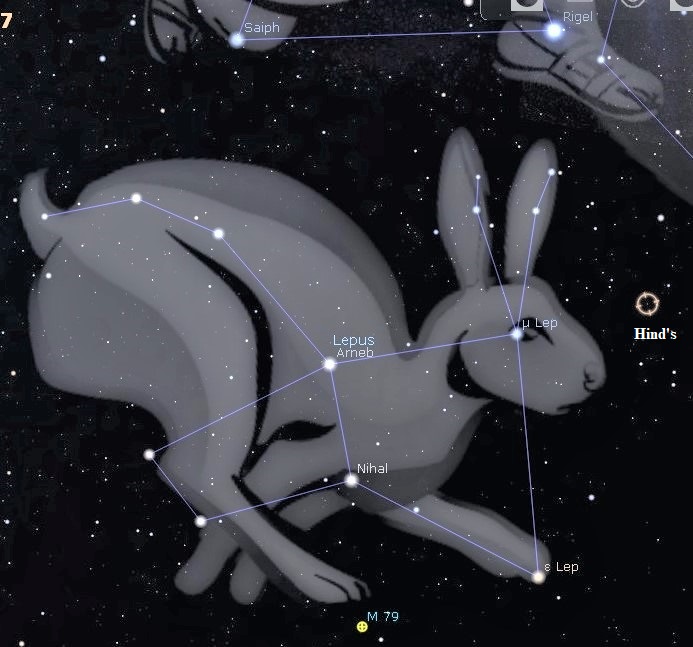This Week’s Sky at a Glance, 2023 January 21 – January 28

This Week’s Sky at a Glance
There are many critters represented as constellations; birds, fish, canines, felines, insects, snakes and even a unicorn. But no rodents have been so honoured, although the second brightest star in Gemini is called Castor, which is the genus of beavers. However, some time ago the cute bunnies decided they didn’t want to be associated with rodents and called themselves lagomorphs. So, at the risk of being attacked by the killer rabbit in Arthurian legend, I will let them represent rodentia this week.
By 9:30 pm Orion stands high in the southern sky while Lepus cowers below his feet, hoping to avoid detection by Orion’s larger canine companion to the east. I see the constellation as three vertical pairs of stars, with the brightest pair in the middle and the widest to the right. With a reasonably dark sky you can see the bunny ears between the widest pair and Orion’s brightest star, Rigel. If you extend the middle pair down an equal distance a small telescope will reveal a fuzzy patch called M79. This globular cluster is unusual in that it is in our winter sky, whereas most of the globulars are seen among the summer constellations. M79 could be part of another galaxy that is interacting with the Milky Way.
If you draw a line from the top of the middle pair to the top of the widest pair and extend it a little more than half that distance, a telescope might pick up Hind’s Crimson Star, one of the reddest stars in the sky. Its brightness varies by a factor of 300 over 14 months, with the red colour being most pronounced at its dimmest.
This Week in the Solar System
Saturday’s sunrise in Moncton is at 7:53 am and sunset will occur at 5:08 pm, giving 9 hours, 15 minutes of daylight (7:55 am and 5:15 pm in Saint John). Next Saturday the Sun will rise at 7:46 am and set at 5:18 pm, giving 9 hours, 32 minutes of daylight (7:49 am and 5:25 pm in Saint John).
The Moon is new on Saturday at the same time it reaches perigee, resulting in extreme tides for a few days. The crescent will be to the upper left of Venus and Saturn early Monday evening, and below Jupiter on Wednesday. Venus and Saturn have a close conjunction on Sunday, with Venus at the beginning of an evening apparition and Saturn heading to a conjunction in February. Telescope users might see Jupiter’s Red Spot around 6:30 Sunday and 8 pm on Tuesday. Mars continues to be brighter than any star except Sirius, passing slowly eastward over Taurus. Mercury is five degrees above the southeastern horizon an hour before sunrise this weekend.
On Sunday evening at 8 pm, tune in to the Sunday Night Astronomy Show via the Facebook page or YouTube channel of Astronomy by the Bay.
Questions? Contact Curt Nason
